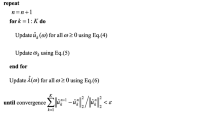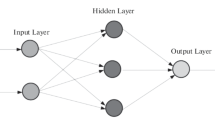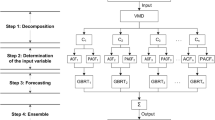Abstract
Precise and reliable monthly runoff prediction plays a vital role in the optimal management of water resources, but the nonstationarity and skewness of monthly runoff time series can pose major challenges for developing appropriate prediction models. To address these issues, this paper proposes a novel hybrid prediction model by introducing variational mode decomposition (VMD) and Box–Cox transformation (BC) into the Elman neural network (Elman), named the VMD-BC-Elman model. First, the observed runoff is decomposed into sub-time series using VMD for better frequency resolution. Second, the input datasets are transformed into a normal distribution using Box–Cox, and as a result, skewedness in the data is removed, and the correlation between the input and output variables is enhanced. The proposed VMD-BC preprocessing technology is expected to overcome the problems arising from nonstationary and skewed runoff data. Finally, Elman is used to simulate the respective sub-time series. The proposed model is evaluated using monthly runoff time series at Zhangjiashan, Zhuangtou and Huaxian hydrological stations in the Wei River Basin in China. The model performances are compared with those of single models (SVM, Elman), decomposition-based (VMD-SVM, VMD-Elman et al.) and BC-based models (BC-SVM and BC-Elman) by employing four metrics. The results show that the hybrid models outperform single models, and the VMD-BC-Elman model performs best in all considered hybrid models with an NSE greater than 0.95, R greater than 0.98, NMSE less than 4.7%, and PBIAS less than 0.4% in both the training and testing periods. The study indicates that the VMD-BC-Elman model is a satisfactory data-driven approach to predict nonstationary and skewed monthly runoff time series, representing an effective tool for predicting monthly runoff series.














Similar content being viewed by others
Availability of Data and Material
The data used to support the findings of this study are available from the corresponding author upon reasonable request.
Code Availability
The code used to support the findings of this study are available from the corresponding author upon reasonable request.
References
Aggarwal SK, Goel A, Singh VP (2012) Stage and discharge forecasting by SVM and ANN techniques. Water Resour Manag 26(13):3705–3724
Barge JT, Sharif HO (2016) An ensemble empirical mode decomposition, self-organizing map, and linear genetic programming approach for forecasting river streamflow. Water 8(2):247
Bojang PO, Yang TC, Pham QB (2020) Linking singular spectrum analysis and machine learning for monthly rainfall forecasting. Appl Sci Basel 10(09)
Box GEP, Cox DR (1964) An analysis of transformations. J Roy Stat Soc B26:211–252
Chandra R (2015) Competition and collaboration in cooperative coevolution of elman recurrent neural networks for time-series prediction. IEEE Trans Neural Netw Learn Syst 26(12):3123–3136
Clark MP, Bierkens MFP, Samaniego L et al (2017) The evolution of process-based hydrologic models: historical challenges and the collective quest for physical realism. Hydrol Earth Syst Sci 21(07):3427–3440
Deb S, Dandapat S, Krajewski J (2020) Analysis and classification of cold speech using variational mode decomposition. IEEE Trans Affect Comput 11(02):296–307
Demirel MC, Venancio A, Kahya E (2009) Flow forecast by SWAT model and ANN in Pracana basin, Portugal. Adv Eng Softw 40(07):467–473
Dragomiretskiy K, Zosso D (2014) Variational mode decomposition. IEEE Trans Signal Process 62(3):531–544
Feng ZK, Niu WJ, Tang ZY, Jiang ZQ, Xu Y, Liu Y, Zhang HR (2020) Monthly runoff time series prediction by variational mode decomposition and support vector machine based on quantum-behaved particle swarm optimization. J Hydrol 583
Hamasaki T, Kim SY (2006) Box and Cox power-transformation to confined and censored non-normal responses in regression. Comput Stat Data Anal 51(8):3788–3799
He XX, Luo JG, Zuo GG, Xie JC (2019) Daily runoff forecasting using a hybrid model based on variational mode decomposition and deep neural networks. Water Resour Manag 33(04):1571–1590
Himanshu SK, Pandey A, Yadav B (2017) Ensemble wavelet-support vector machine approach for prediction of suspended sediment load using hydrometeorological data. J Hydrol Eng 22(07)
Huang N, Chen H, Cai G, Fang L, Wang Y (2016) Mechanical fault diagnosis of high voltage circuit breakers based on variational mode decomposition and multi-layer classifier. Sensors 16(11)
Huang NE, Wu MLC, Long SR, Shen SSP, Qu WD, Gloersen P, Fan KL (2003) A confidence limit for the empirical mode decomposition and Hilbert spectral analysis. Proc R Soc Math Phys Eng Sci 459(08):2317–2345
Jiang RG, Wang YP, Xie JC, Zhao Y, Li FW, Wang XJ (2019) Assessment of extreme precipitation events and their teleconnections to El Nino southern oscillation, a case study in the Wei River basin of China. Atmos Res 218:372–384
Karamouz M, Ahmadi A, Moridi A (2009) Probabilistic reservoir operation using Bayesian stochastic model and support vector machine. Adv Water Resour 32(11):1588–1600
Krishnan S, Lokesh S, Devi MR (2019) An efficient Elman neural network classifier with cloud supported internet of things structure for health monitoring system. Comput Netw 14(5):201–210
Kuremoto T, Kimura S, Kobayashi K, Obayashi M (2014) Time series forecasting using a deep belief network with restricted Boltzmann machines. Neurocomputing 137:47–56
Li H, Fan BJ, Jia R, Zhai F, Bai L, Luo XQ (2020) Research on multi-domain fault diagnosis of gearbox of wind turbine based on adaptive variational mode decomposition and extreme learning machine algorithms. Energies 13(6):1375
Li XY, Zhang L, Wang ZP, Dong P (2019) Remaining useful life prediction for lithium-ion batteries based on a hybrid model combining the long short-term memory and Elman neural networks. J Energy Stor 21:510–518
Mehrgini B, Izadi H, Memarian H (2019) Shear wave velocity prediction using Elman artificial neural network. Carbonates Evaporites 34(04):1281–1291
Milani MRM, Hense A, Rahmani E, Ploeger A (2016) Applying least absolute shrinkage selection operator and akaike information criterion analysis to find the best multiple linear regression models between climate indices and components of Cow’s Milk. Foods 5(4):52. https://doi.org/10.3390/foods5030052
Mohanty S, Gupta KK, Raju KS (2018) Hurst based vibro-acoustic feature extraction of bearing using EMD and VMD. Measurement 117:200–220
Myronidis D, Ioannou K, Fotakis D, Dorflinger G (2018) Streamflow and hydrological drought trend analysis and forecasting in Cyprus. Water Resour Manag 32(5):1759–1776
Nash J, Sutcliffe J (1970) River flow forecasting through conceptual models part I—a discussion of principles. J Hydrol 10(3):282–290
Packard NH, Crutchfieid JP, Farmer JD et al (1980) Geometry from a time series. Phys Rev Lett 45:712
Pan B, Han M, Wei F, Tian LX, Liu YT, Li YL, Wang M (2021) Analysis of the variation characteristics of runoff and sediment in the yellow river within 70 years. Water Resour 48(05):676–689
Peng Y, Wang GL, Tang GL, Zhou HC, Wang YJ, Jian DP (2011) Study on reservoir operation optimization of Ertan hydropower Station considering GFS forecasted precipitation. Sci China-Technol Sci 54:76–82
Sankaran A, Reddy MJ (2016) Analyzing the hydroclimatic teleconnections of summer monsoon rainfall in Kerala, India, using multivariate empirical mode decomposition and time-dependent intrinsic correlation. IEEE Geosci Remote Sens Lett 13(9):1221–1225
Sarlak N (2008) Annual streamflow modelling with asymmetric distribution function. Hydrol Process 22(17):3403–3409
Sedki A, Quazar D, EI Mazoudi E (2008) Evolving neural network using real coded genetic algorithm for daily rainfall-runoff forecasting. Expert Syst Appl 36:4523–4527
Seong KW (2014) Deriving a practical form of IDF formula using transformed rainfall intensities. Hydrol Process 28(06):2881–2896
Song PB, Liu WF, Sun JH, Wang C, Kong LZ, Nong ZX, Lei XH, Wang H (2020) Annual runoff forecasting based on multi-model information fusion and residual error correction in the Ganjiang River Basin. Water 12(08)
Taylor KE (2001) Summarizing multiple aspects of model performance in a single diagram. J Gerontol Ser A Biol Med Sci 106(D7):7183–7192
Tiwari MK, Adamowaki J (2013) Urban water demand forecasting and uncertainty assessment using ensemble wavelet-bootstrap-neural network models. Water Resour Res 49(10):6486–6507
Troin M, Caya D (2014) Evaluating the SWAT’s snow hydrology over a Northern Quebec watershed. Hydrol Process 28(04):1858–1873
Vasiliades L, Loukas A (2009) Hydrological response to meteorological drought using the Palmer drought indices in Thessaly. Greece Desalination 237(1–3):3–21
Wang QY, Liu Y, Yue QM, Zheng YX, Yao XL, Yu JS (2020) Impact of input filtering and architecture selection strategies on GRU runoff forecasting: A case study in the Wei River Basin, Shaanxi, China. Water 12(12)
Wang WC, Xu DM, Chau KW, Chen S (2013) Improved annual rainfall-runoff forecasting using PSO-SVM model based on EEMD. J Hydroinf 15(4):1377–1390
Wen XH, Feng Q, Deo RC et al (2019) Two-phase extreme learning machines integrated with the complete ensemble empirical mode decomposition with adaptive noise algorithm for multi-scale runoff prediction problems. J Hydrol 570:167–184
Wu Z, Huang NE (2009) Ensemble empirical mode decomposition: A noise-assisted data analysis method. Adv Adapt Data Anal 1(1):1–41
Yu YH, Zhang HB, Singh VP (2018) Forward prediction of runoff data in data-scarce basins with an improved ensemble empirical mode decomposition (EEMD) Model. Water 10(04)
Zhang X, Peng Y, Zhang C, Wang B (2015) Are hybrid models integrated with data preprocessing techniques suitable for monthly streamflow forecasting? Some experiment evidences. J Hydrol 530:137–152
Zou L, Xia J, She DX (2018) Analysis of impacts of climate change and human activities on hydrological drought: a case study in the Wei River basin, China. Water Resour Manag 32(4):1421–1438
Acknowledgements
This research was funded by Science-Technology Plan Program of Water Conservancy Fund of Shaanxi Province, grant number 2019slkj-14, and National Natural Science Foundation of China under grant 5149222, 52079110. Sincere gratitude is extended to the editor and anonymous reviewers for their professional comments and corrections.
Author information
Authors and Affiliations
Contributions
Fangqin Zhang: Investigation, Modeling, Calculation, Writing-Original Draft. Yan Kang: Conceptualization, Methodology, Writing-Review & Editing, Supervision. Xiao Cheng: Investigation, Data curation. Peiru Chen: Investigation. Songbai Song: Writing-Review & Editing.
Corresponding author
Ethics declarations
Ethics Approval
Not applicable.
Consent to Participate
Not applicable.
Consent to Publication
Not applicable.
Conflict of Interest
The authors declared that they have no conflicts of interest to this work.
Additional information
Publisher's Note
Springer Nature remains neutral with regard to jurisdictional claims in published maps and institutional affiliations.
Rights and permissions
About this article
Cite this article
Zhang, F., Kang, Y., Cheng, X. et al. A Hybrid Model Integrating Elman Neural Network with Variational Mode Decomposition and Box–Cox Transformation for Monthly Runoff Time Series Prediction. Water Resour Manage 36, 3673–3697 (2022). https://doi.org/10.1007/s11269-022-03220-2
Received:
Accepted:
Published:
Issue Date:
DOI: https://doi.org/10.1007/s11269-022-03220-2




